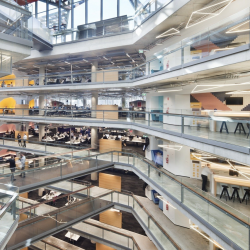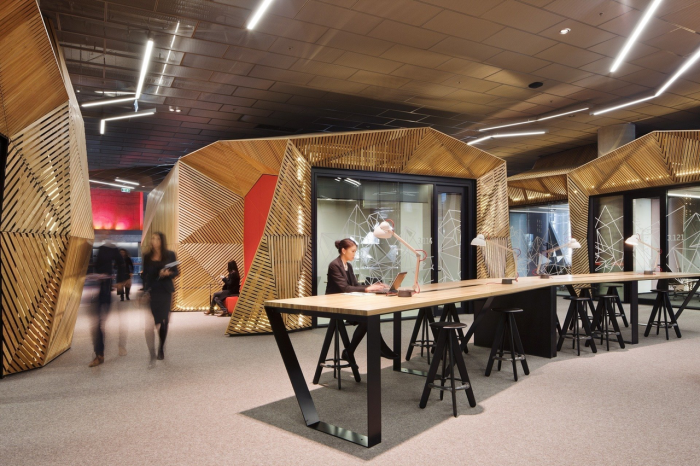 Over half of those employed in the banking sector in Australia now find themselves in agile and dynamic activity based workplaces. The banks have set the pace. The overall growth of the phenomenon has been exponential in the last 5 years, with sources suggesting two thirds of Australian organisations will have adopted Activity Based Working (ABW) by 2020. Furthermore, by looking at the number of Activity Based Working projects in the pipeline this move away from the 20th century office seems unstoppable. Despite global economic challenges the banking sector in Australia is particularly strong and stable, which contributes to the organisations’ ability to take a long term view. Alongside this robust financial picture we are also seeing a shift in purpose emerge, where the banks move away from a purely financial role to one where they embrace a sense of community and stewardship thus developing a broader contribution to society.
Over half of those employed in the banking sector in Australia now find themselves in agile and dynamic activity based workplaces. The banks have set the pace. The overall growth of the phenomenon has been exponential in the last 5 years, with sources suggesting two thirds of Australian organisations will have adopted Activity Based Working (ABW) by 2020. Furthermore, by looking at the number of Activity Based Working projects in the pipeline this move away from the 20th century office seems unstoppable. Despite global economic challenges the banking sector in Australia is particularly strong and stable, which contributes to the organisations’ ability to take a long term view. Alongside this robust financial picture we are also seeing a shift in purpose emerge, where the banks move away from a purely financial role to one where they embrace a sense of community and stewardship thus developing a broader contribution to society.
Culturally the folks down under are driven, always seeking to improve. They are natural pioneers, hungry to find new and better ways to do things. With an eagerness to challenge established processes and an ability to learn across projects and across silos, helped by the relatively small network of individuals involved, they are achieving change on a huge scale.
Without exception, the banks’ transformation was initiated, sponsored and supported from the highest level. Whilst it’s fair to say that the potential cost savings were a key initial driver, what makes the banking sector’s journey so remarkable is that this is no longer the main driver for continuing and enhancing the approach. The most talked about and reported benefits focus on the cultural transformation enabled by the new workplace.
With the market dictating the need for an agile, digital, automated, yet highly personalised approach to modern banking, the mindset has really broadened in the last 2 years with flexible working policies a strong driver behind the integration of HR, technology and workplace strategies. In our case studies on ANZ, NAB, Macquarie and the Commonwealth Bank you will see how they have embraced an ABW style development which is all about fostering collaboration to enhance innovation and transparency. This new mindset is now the main driver to continue on this journey.
 With around two thirds of Australian office workers expected to be working in some form of dynamic workplace by 2020 it is clear that the Activity Based Working phenomenon has now extended well beyond the banking sector. To reignite engagement and drive performance, particularly in the areas of collaboration, innovation and customer connection any organization will have to find a way to express its purpose, brand and cultural values through a multitude of channels.
With around two thirds of Australian office workers expected to be working in some form of dynamic workplace by 2020 it is clear that the Activity Based Working phenomenon has now extended well beyond the banking sector. To reignite engagement and drive performance, particularly in the areas of collaboration, innovation and customer connection any organization will have to find a way to express its purpose, brand and cultural values through a multitude of channels.
In visiting and studying organisations in the public sector, where there are clear responsibilities beyond profit making, this connection seems even more obvious. To serve local individuals and improve their communities, as we see in the City of Casey example, some local governments are embracing a truly dynamic approach. They’re placing themselves right at the heart of the community they serve, becoming truly open and welcoming by sharing their workplace with the public.
It’s valuable to understand that the uptake of agile workplaces in the public sector is not yet widespread. The main factors attributed to this slower development probably articulate key barriers seen more generally across a range of industries. Leadership is top of the list, the mechanism for decision making varies with different types of organizations. The public sector in particular needs a strong leadership narrative around new ways of working, with coherent linkage to the needs of the organisation.
All practitioners in this field will be familiar with the challenge of making the business case for smart working, how to overcome the business disruption risk and how to measure benefits. This study will help readers to make the case that it is more a matter of why an organisation wouldn’t consider this type of workplace strategy given the huge benefits secured by a cross-section of organisations.
Particularly in the private sector, the folks ‘Down Under’ are prepared to go for it and take a leap of faith, when it seems like ‘the right thing to do’. There was real recognition that in certain cases it is impossible to fully predict the outcome of a complex organisational and cultural change, but that standing still was not an option.
Our study, Smart Working on the Antipodes, confirms the widespread take-up of this alternative office workplace strategy and will appeal to those who are involved in both the consumption and the production of offices and workplaces. All of them are facing a common challenge; that of doing more with less. Whilst flexible working practices at home or third spaces are undoubtedly on the rise, it is interesting to note that little evidence was found of comprehensive agile working practices. The many references to outcomes-based thinking would support these, yet there seemed to be a preference to try and entice people into the workplace instead. Once you dig deeper into the report an understanding emerges, that the desire for the workspace to help transform organisational culture is a key driver in shaping spaces and places.
Images: National Australia Bank, Melbourne designed by Woods Bagot
__________________________________
 Max Luff is the Managing Director of Six Ideas. She can be contacted at max.luff@six-ideas.com.
Max Luff is the Managing Director of Six Ideas. She can be contacted at max.luff@six-ideas.com.


















May 30, 2018
Australia is leading the world in the adoption of activity based working
by Max Luff • Comment, Flexible working, Workplace design
Culturally the folks down under are driven, always seeking to improve. They are natural pioneers, hungry to find new and better ways to do things. With an eagerness to challenge established processes and an ability to learn across projects and across silos, helped by the relatively small network of individuals involved, they are achieving change on a huge scale.
Without exception, the banks’ transformation was initiated, sponsored and supported from the highest level. Whilst it’s fair to say that the potential cost savings were a key initial driver, what makes the banking sector’s journey so remarkable is that this is no longer the main driver for continuing and enhancing the approach. The most talked about and reported benefits focus on the cultural transformation enabled by the new workplace.
With the market dictating the need for an agile, digital, automated, yet highly personalised approach to modern banking, the mindset has really broadened in the last 2 years with flexible working policies a strong driver behind the integration of HR, technology and workplace strategies. In our case studies on ANZ, NAB, Macquarie and the Commonwealth Bank you will see how they have embraced an ABW style development which is all about fostering collaboration to enhance innovation and transparency. This new mindset is now the main driver to continue on this journey.
In visiting and studying organisations in the public sector, where there are clear responsibilities beyond profit making, this connection seems even more obvious. To serve local individuals and improve their communities, as we see in the City of Casey example, some local governments are embracing a truly dynamic approach. They’re placing themselves right at the heart of the community they serve, becoming truly open and welcoming by sharing their workplace with the public.
It’s valuable to understand that the uptake of agile workplaces in the public sector is not yet widespread. The main factors attributed to this slower development probably articulate key barriers seen more generally across a range of industries. Leadership is top of the list, the mechanism for decision making varies with different types of organizations. The public sector in particular needs a strong leadership narrative around new ways of working, with coherent linkage to the needs of the organisation.
All practitioners in this field will be familiar with the challenge of making the business case for smart working, how to overcome the business disruption risk and how to measure benefits. This study will help readers to make the case that it is more a matter of why an organisation wouldn’t consider this type of workplace strategy given the huge benefits secured by a cross-section of organisations.
Particularly in the private sector, the folks ‘Down Under’ are prepared to go for it and take a leap of faith, when it seems like ‘the right thing to do’. There was real recognition that in certain cases it is impossible to fully predict the outcome of a complex organisational and cultural change, but that standing still was not an option.
Our study, Smart Working on the Antipodes, confirms the widespread take-up of this alternative office workplace strategy and will appeal to those who are involved in both the consumption and the production of offices and workplaces. All of them are facing a common challenge; that of doing more with less. Whilst flexible working practices at home or third spaces are undoubtedly on the rise, it is interesting to note that little evidence was found of comprehensive agile working practices. The many references to outcomes-based thinking would support these, yet there seemed to be a preference to try and entice people into the workplace instead. Once you dig deeper into the report an understanding emerges, that the desire for the workspace to help transform organisational culture is a key driver in shaping spaces and places.
Images: National Australia Bank, Melbourne designed by Woods Bagot
__________________________________